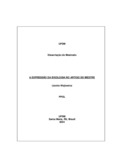| dc.creator | Wojtowicz, Licéria | |
| dc.date.accessioned | 2006-11-10 | |
| dc.date.available | 2006-11-10 | |
| dc.date.issued | 2004-07-20 | |
| dc.identifier.citation | WOJTOWICZ, Licéria. THE EXPRESSION OF IDEOLOGY IN THE MASTER S ARTICLE. 2004. 97 f. Dissertação (Mestrado em Letras) - Universidade Federal de Santa Maria, Santa Maria, 2004. | por |
| dc.identifier.uri | http://repositorio.ufsm.br/handle/1/9756 | |
| dc.description.abstract | Textual genres, while communicative events, have been the focus of interest of researchers who aim at explaining the process involved in their manifestation. The Master s Article of the Sheicho-No-Ie Fonte de Luz issue was chosen as corpus. Texts that were published from October 1996 to March 2004, signed by Masaharu Taniguchi were selected to verify the features which comprise these texts as textual genres. Teun van Dijk was chosen as the basis for the analysis of certain structures which can portray ideology. The analysis was also supported by Meurer (1997a, 1997b, 1998, 2002) on a distinction between textual genre and rethorical mode, and on the concepts of Halliday & Hasan (1998) about the relation of text and context. The religious issue was based on the studies of Orlandi (1987), and the concepts of self-help were supported by Chagas (1999, 2002). It was observed the occurrence of basic textual structures of situation-problem-evaluation-solution and hypotheticality. In relation to speech acts there was a prevalence of questions, statements and threatening. In the microstructural analysis it was observed that the modalizers, the pronoun we, and the connector if, among other discoursive structures, portray ideological meanings. It was also observed the narrative, description, exortation and exposition as rethorical mode. This study intends to contribute to researches in the area of language, through the description of a religious-oriented genre, and to bring some light into the discussions of ideologycal issues, which are implicit in the master s discourse, as well as, to show how social and religious representations are expressed in genres, which are part of the society, and which are perpetuated through language. | eng |
| dc.format | application/pdf | por |
| dc.language | por | por |
| dc.publisher | Universidade Federal de Santa Maria | por |
| dc.rights | Acesso Aberto | por |
| dc.subject | Gênero textual | por |
| dc.subject | Discurso religioso | por |
| dc.subject | Ideologia | por |
| dc.subject | Textual genre | eng |
| dc.subject | Religious discourse | eng |
| dc.subject | Ideology | eng |
| dc.title | A expressão da ideologia no artigo do mestre | por |
| dc.title.alternative | The expression of ideology in the master s article | eng |
| dc.type | Dissertação | por |
| dc.description.resumo | Os gêneros textuais como eventos comunicativos têm despertado o interesse de pesquisadores nos processos que envolvem a sua manifestação. O Artigo do Mestre da revista Fonte de Luz da Seicho-no-Ie, do período de outubro de 1996 a março de 2004, de autoria do mestre Masaharu Taniguchi, foi escolhido como corpus. Teun van Dijk (2000) foi tomado aqui como base para chegar às estruturas capazes de veicular a ideologia. O trabalho também se fundamentou nos pressupostos de Meurer, (1997a, 1997b, 1998, 2002), sobre a distinção entre gênero textual e modalidade retórica e nos conceitos de Halliday & Hasan (1989) sobre a relação de texto e contexto. A questão da religião tomou como base os estudos de Orlandi (1987a, 1987b), e os conceitos de auto-ajuda fundamentaram-se nas obras de Chagas (1999/2002). Observou-se a ocorrência das estruturas textuais básicas situação-avaliação e hipotético-real. Em relação aos atos de fala, houve a predominância de perguntas, asserção e da ameaça. Na análise microestrutural, constatou-se que os modalizadores, o pronome nós e o conector se, dentre outras estruturas discursivas, veiculam significados ideológicos. Observou-se a freqüência da modalidade retórica narrativa, descritiva, exortativa e expositiva. Este trabalho pretende contribuir para os estudos na área da linguagem ao descrever um gênero de orientação religiosa e trazer à discussão questões ideológicas implícitas no discurso do mestre, bem como explicitar como as representações sociais e religiosas se evidenciam nos gêneros que circulam na sociedade e se perpetuam através da linguagem. | por |
| dc.contributor.advisor1 | Barros, Nina Célia Almeida de | |
| dc.contributor.advisor1Lattes | http://buscatextual.cnpq.br/buscatextual/visualizacv.do?id=K4794805E8 | por |
| dc.contributor.referee1 | Toldo, Claudia Stumpf | |
| dc.contributor.referee1Lattes | http://buscatextual.cnpq.br/buscatextual/visualizacv.do?id=K4770841D1 | por |
| dc.contributor.referee2 | Roth, Désirée Motta | |
| dc.contributor.referee2Lattes | http://buscatextual.cnpq.br/buscatextual/visualizacv.do?id=K4793139Y7 | por |
| dc.creator.Lattes | http://buscatextual.cnpq.br/buscatextual/visualizacv.do?id=K4771043J1 | por |
| dc.publisher.country | BR | por |
| dc.publisher.department | Letras | por |
| dc.publisher.initials | UFSM | por |
| dc.publisher.program | Programa de Pós-Graduação em Letras | por |
| dc.subject.cnpq | CNPQ::LINGUISTICA, LETRAS E ARTES::LETRAS | por |


